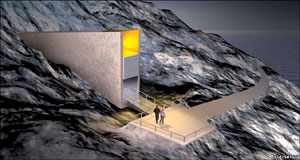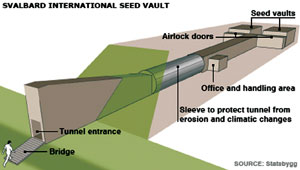|
Aunt Mali's Children
Do you know:
'Doomsday' seed bank !
 Deep in Norway's frozen Svalbard archipelago sits a high-tech
facility that could save the world. If global catastrophes like asteroid
impacts or disease pandemics were to strike, seeds stored in this first
ever 'doomsday' vault would ensure that humans could re-grow the crops
needed for survival. But the vault can also save us from a more gradual
disaster: Everyday little-known crop varieties are going extinct. Deep in Norway's frozen Svalbard archipelago sits a high-tech
facility that could save the world. If global catastrophes like asteroid
impacts or disease pandemics were to strike, seeds stored in this first
ever 'doomsday' vault would ensure that humans could re-grow the crops
needed for survival. But the vault can also save us from a more gradual
disaster: Everyday little-known crop varieties are going extinct.
 These crops, researchers say, are the raw genetic materials needed
for breeders to adapt the global food supply to survive climate change,
water and energy shortages, and even shifts in food preferences. These crops, researchers say, are the raw genetic materials needed
for breeders to adapt the global food supply to survive climate change,
water and energy shortages, and even shifts in food preferences.
The trust is the leading force behind the Svalbard Global Seed Vault,
a repository built by the Norwegian government to store backup copies of
as many as three million different crop varieties. The vault, carved
into a mountainside on the Norwegian island of Spitsbergen, will open
for storage in February 2008. The Svalbard project is a global version
of a seed bank, a concept that has been around since the 1920s.
###############################
Lesson from a fable:
The two horses
Two horses were carrying two loads. The front horse went well, but
the rear horse was lazy.
The owner of the horses began to pile the rear horse's load on the
front horse; when they had transferred it all, the rear horse found it
easy going, and he said to the front horse, "Toil and sweat! The more
you try, the more you have to suffer."
When they reached the tavern, the owner said "Why should I fodder two
horses when I carry all on one? I had better give the one all the food
it wants, and cut the throat of the other; at least I shall have the
hide". So he did.
A fable from Leo Tolstoy.
###########################
For your book of facts:
Birth and spread of Islam
Muhammad's vision
Before 800 B.C. the people of Western Arabia had developed a written
language, Arabic. By A.D. 500 Arab traders had developed thriving trade
routes.
Into this bustling civilization, Muhammad was born in the oasis city
of Mecca in about A.D. 570. He was orphaned as a boy and was raised by
an uncle who was a trader. While growing up, Muhammad mastered the skill
of leading caravans. His skills came to the attention of a wealthy widow
and merchant, Khadija. Working for her, Muhammad travelled to the
Fertile Crescent to trade goods. When he returned from his journey, he
and Khadija were married.
Muhammad had time to devote himself to thinking about religion. He
was about 40 years old, according to Islamic tradition, when he went to
a mountain cave to pray. There he had a vision. In the vision, the angel
Gabriel appeared to him and said, "O, Muhammad, you are the prophet of
Allah." As you learned in Chapter 2, a prophet is believed to speak for
God. Muhammad's vision would lead to the creation of a new religion
called Islam. A person who believes in Islam is known as a Muslim Islam
would mark a turning point in the history of Arabia.
Mecca and the Kaaba
The city of Mecca, lay on the main trading route through western
Arabia. The city also attracted other visitors. They came to pray at the
Kaaba Mecca's square-shaped temple. "Kaaba" is the Arabic word for
"cube". The Kaaba housed a sacred black stone and honoured the gods and
goddesses worshipped by the people of Mecca.
The religion of Islam
Muhammad was determined to persuade the people of Mecca to abandon
their worship of many gods and goddesses. He set out to teach people in
Mecca about Allah, and to worship only one God. Over the next three
years, his group of followers slowly grew.
Opposition in Mecca
In spreading his beliefs, Muhammad aroused the anger of the leaders
of Mecca. They were upset for many reasons.
The main reason was that he criticized the Meccans' way of life and
their belief in many gods. They also looked down on Muhammad because of
his humble birth. The leaders of Mecca also feared that they would lose
trade if pilgrimages to the Kaaba stopped.
Muhammad's migration
In 622 Muhammad was forced to flee from Mecca. He settled in another
oasis town, Medina over 200 miles north of Mecca. Muhammad's Hijra
Arabic for "migration" from Mecca to Medina marked a major turning point
in Islamic history. The year of the hijra, 622, marks the staring point
of the Islamic calendar.
In Medina, many people accepted Muhammad's teachings. There he
organized a government and an army. In 630, with an army of 10,000, he
entered Mecca in triumph.
After his victory, Muhammad destroyed the statues of the gods and
goddesses in the Kaaba and proclaimed Mecca a Muslim city. The Grand
Mosque in Mecca contains the Kaaba. A mosque is a building where Muslims
worship.
Islam grows
In 632, just before he died, Muhammad is said to have spoken to his
followers at Mecca in these words: "Muslim believers are brothers of one
another." By the time Muhammad died in 632, he had united most of
Arabia.
The Quran Sacred book of Islam
After Muhammad's death, his teachings were written down by his
followers in what became the holy book of Islam. It is called the Quran.
The most important teaching in the Quran is that there is only one God
in the universe -Allah. This belief in only one God makes Islam a
monotheistic religion, like Judaism and Christianity. The Quran says
that Allah is the God worshipped both by Christians and Jews.
The Quran serves as a guide for living for Muslims, as the Torah does
for Jews and the Bible does for Christians. Through its words, Muslims
learn about Allah's teachings.
Next week - Growth of the Muslim Empire
##################################
The five pillars of Islam
In the Quran are the five basic duties of all Muslims. The purpose of
these duties, known as the Five Pillars of Islam, is to strengthen
Muslims' ties to Allah and to other people.
* The first pillar is the belief in one God, Allah, and that Muhammad
is Allah's prophet.
* The second pillar describes the prayers Muslims offer Allah five
times each day. Wherever they are in the world, Muslims look toward
Mecca, their holy city, as they pray.
* The third pillar speaks of giving to those in need.
* The fourth pillar instructs Muslims to fast during the holy month
of Ramadan. During Ramadan Muslims neither eat nor drink from sunrise to
sunset. They spend time in worship.
* The final pillar instructs Muslims who can afford it to go on a
hajj, or journey to visit Mecca, at least once in their lives. A journey
for religious purposes is called a pilgrimage.
################################
Fruits
The orange
Sits on the table
Its perfect skin
Glistening
Like a miniature sun...
The Apple
Sits in the basket
Coloured in red
Dark
Like a drop of blood...
The banana
Sits in its bunch
Robed in yellow
Curved
Like a smiling mouth...
Nillasi Liyanage
Gr-9, Musaeus College,
Colombo 7. |

